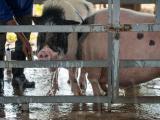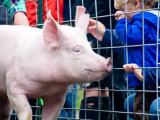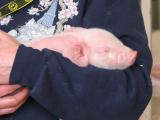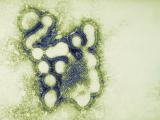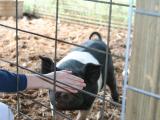Aug 3, 2012 (CIDRAP News) – The number of variant swine-origin H3N2 (H3N2v) influenza cases in the United States has reached 16 in the past 3 weeks and 29 in the past year, prompting health officials to watch the virus closely for any increase in its now-limited ability to spread from person to person, the Centers for Disease Control and Prevention (CDC) said today.
The agency said 15 of the 16 recent cases have been in people, mostly children, who visited or were involved in county fairs, and the 16th case was in a farmer who has pigs. All the recent patients have recovered without hospitalization, though three of the earlier cases involved inpatient care, the CDC said.
"Twenty-nine cases is a significant number of detections of this type of virus in recent years," Joseph Bresee, MD, of the CDC's Influenza Division, said at a press conference today.
The virus contains the M, or matrix, gene from the 2009 H1N1 flu virus, he noted, adding, "This may confer increased transmissibility to and among humans compared to other variant influenza viruses."
Of the 29 cases in the past year, three that occurred last fall and winter are believed to have involved limited person-to-person transmission, Bresee said.
The illness caused by H3N2v is impossible to distinguish clinically from seasonal flu, he said. "I think the difference between this virus and seasonal viruses is that this virus doesn't spread efficiently in humans," he commented. "It's still principally a swine virus, so when it affects humans it can cause illness but it doesn't seem to have onward spread."
Nonetheless, the CDC recommended taking precautions to avoid contracting the virus through exposure to pigs. People who have an increased risk of flu complications, including the elderly, children ages 5 and under, pregnant women, and those with chronic medical conditions should consider staying away from pigs and swine barns this summer, especially if sick pigs have been identified, the agency said.
"This virus may be circulating widely in US swine at this time," the CDC said in a report released today. And at the press conference, Lisa Ferguson, DVM, of the US Department of Agriculture, said the virus has been found in pigs in 11 states.
Cases by state
The latest 16 cases include 1 in Hawaii, 5 in Indiana, and 10 in Ohio. All but one of these—the 10th Ohio case—were reported previously. The CDC said all five Indiana cases were related to county fairs, and all 10 Ohio cases likewise were associated with a fair, identified previously as the Butler County Fair. The Hawaii case, reported Aug 1, was in a Maui resident.
Today's CDC report said the overall H3N2v case count by state since July 2011 includes Hawaii, 1; Indiana, 7; Iowa, 3; Ohio, 10; Maine, 2; Pennsylvania, 3; Utah, 1; and West Virginia, 2.
It remained unclear today whether the Maui patient had any exposure to pigs. Bresee said no link between the Hawaii cases and other recent cases has been found. "From the epidemiologic investigation we don't have a link between humans or pigs in Hawaii and humans or pigs in Indiana and Ohio," he said.
The CDC said today, as it has previously, that studies have indicated that children under age 10 have little or no immunity against the H3N2v virus, whereas adults may have some cross-protective immunity. That finding matches up with the preponderance of children in the reported cases.
Breseee said the seasonal flu vaccine is unlikely to provide protection against H3N2v, because the latter is substantially different from the H3N2 component of the vaccine.
However, the CDC has developed a candidate vaccine for H3N2v, and clinical trials are expected to be conducted before the end of this year, officials have said.
Virus first identified in 2010
Ferguson said the H3N2 virus with the M gene from pH1N1 was first detected in swine in the summer of 2010. "We've had samples essentially from 11 states that show that similar type of virus in the intervening time frame," she said.
To reduce the risk of catching the virus, the CDC today listed a number of precautions, including washing hands thoroughly before and after exposure to animals, avoiding eating and drinking while in animal areas, and avoiding close contact with animals that look or act sick.
The agency noted that variant H3N2 does not spread through eating properly handled and cooked pork.
Chronic conditions that increase the risk of flu complications include asthma, diabetes, heart disease, weakened immunity, and neurologic or neurodevelopmental conditions, the CDC noted. It said those who have such conditions should consider avoiding exposure to pigs this summer.
The antiviral drugs oseltamivir (Tamiflu) and zanamivir (Relenza) are expected to be effective in treating H3N2v illness, the CDC noted today. But it said rapid flu tests may not detect the virus in human specimens, so samples should be tested at state health departments if it is suspected.
In related news today, the Ohio Department of Health said two sick pigs were sent home from the Ohio State Fair yesterday and that testing of the pigs was under way.
In Indiana, the State Department of Health announced the launch of a call center to provide information about flu. The center was open this afternoon and will be open on weekdays starting next week, officials said today.
See also:
Aug 3 CDC report on recent H3N2v cases
Aug 3 Ohio Department of Health press release
Aug 3 Indiana Department of Health press release
Aug 2 CIDRAP News story on H3N2v cases
